Company: Starbucks
CEO: Laxman Narasimhan
Year founded : 1971
Headquarter : Seattle, USA
Number of Employees (FY2023): 381,000
Type: Public
Ticker Symbol: SBUX
Market Cap (Jul 2024): $89.79 Billion
Annual Revenue (FY2023): $35.98Billion
Profit (Net income) (FY2023): $4.12 Billion
Products & Services: Coffee | Handcrafted Beverages | Fresh food | Non-food items | Packaged goods | Mugs and accessories | Gifts |
Competitors: Costa Coffee | McDonalds McCafe | Dunkin Donuts | Café Coffee Day | Tim Hortons | Costa Coffee | Panera Bread |
Did you know?
Starbucks is named for the first mate in Herman Melville’s novel ‘Moby-Dick.’
There are 170,000 possible drink combinations at Starbucks.
An Overview of Starbucks
Starbucks is the world’s largest coffeehouse chain, with over 38,000 locations in 86 markets. Starbucks was founded in Seattle, Washington in 1971, with one of the first locations in the historic Pike Place Market. While the US has more Starbucks locations than any other country, global expansion has been a priority for the company. In fact, the number of locations almost doubled in the past decade with the help of international expansion.
When it started, Starbucks was primarily a roaster of coffee beans and seller of whole beans and ground coffee, tea and spices.
With the invigorating vision of Howard Schultz, who bought Starbucks from its founders in the 1980s, it became more than a supplier of coffee beans and roasting equipment.
After a visit to Milan, Italy, Schultz was captivated by the coffee culture in the city. He introduced the coffee shop experience we know today in Starbucks stores.
Laxman Narasimhan is the current CEO of Starbucks.
SWOT analysis of Starbucks
The SWOT analysis of Starbucks is as follows:
Starbucks Strengths – Internal Strategic Factors
1. Strong Brand Image
Starbucks Corporation is a popular and strong brand in the food and beverage industry. Its size, volume, and the number of loyal customers have kept growing over time. Starbucks has become associated with excellent customer service and quality coffee.
According to the latest Interbrand ranking, Starbucks holds the #48 position in the top 100 best global brands. It has a brand value of $15.4 Billion.
2. Impressive Financial Performance
With an annual revenue of $36 billion and a profit of $4.12 Billion in fiscal year 2023, Starbucks has a strong financial position in the market. The company has historically shown it is a stable business through consistent revenue growth and profitability figures.
3. Growth in Stores
The number of Starbucks locations has grown almost every year, with the exception of a slight drop in 2009 due to global economic factors caused by the financial crisis. However, the number of stores has almost doubled over the past ten years, to 38,038 in 2023.
Currently, Starbucks operates two types of stores, company-operated and licensed locations, and is active in more than 80 countries.
In 2018, for the first time, there were more Starbucks stores outside the US than inside. As of 2023, there were 17,810 stores in the US and 20,228 located in other countries.
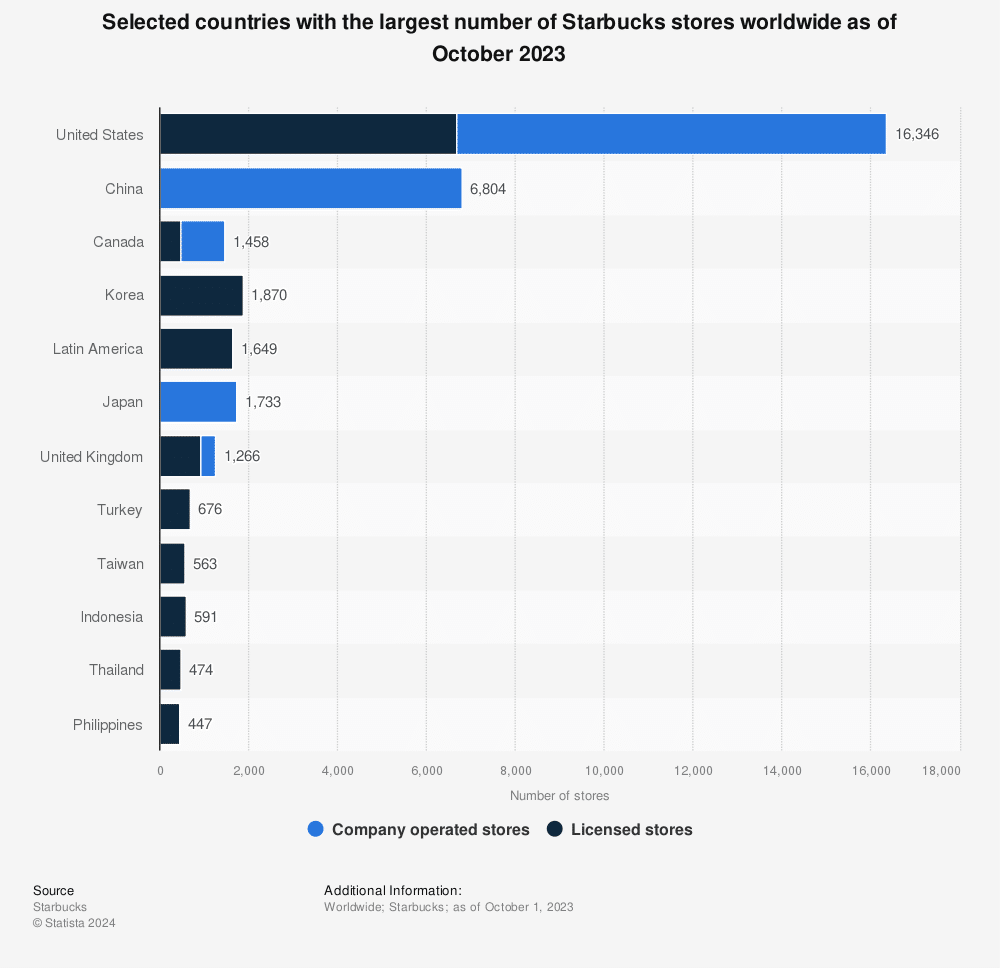
Source: Statista
4. Extensive International Supply Chain
Starbucks is known to have an extensive global network of suppliers developed over the last two decades. Starbucks sources its coffee beans from three coffee producing regions, Latin-America, Africa, and Asia-Pacific.
5. Acquisitions
Starbucks has acquired and integrated several other companies, including Seattle’s Best Coffee, Teavana, Tazo, Evolution Fresh, Torrefazione Italia Coffee, and Ethos Water. These acquisitions have proven quite successful for Starbucks.
6. Moderate Diversification
Starbucks has also diversified its business operations by introducing innovative merchandise and food items. One such example is the addition of ice cubes made of Coffee, which results in a stronger Coffee flavor. It also offers more tea and fresh juice, thanks in part to acquisitions.
7. Quality, Taste and Standardization
Due to its premium blends and delicious coffees, Starbucks has expanded globally. It offers excellent quality and consistently standardized products in all locations.
8. Efficiency, Strategic Planning, and Reinvestment Strategy
Starbucks reinvests its profits by expanding its business in different locations. Its efficient operations and well-planned strategic decisions have produced many advantages for the company.
9. Employee Treatment
The company treats its employees relatively well, which eventually translates into happier employees serving happier customers. Starbucks has been listed as one of the best companies for which to work. Recently, Forbes has ranked Starbucks in the following categories:
- World’s Top Companies for Women (#14)
- Canada’s Best Employers for Diversity (#36)
Starbucks offers health coverage to eligible full-time and part-time employees. It also offers company stocks and the chance to earn tuition reimbursement for bachelor’s degrees.
10. Strong Loyalty Program
Starbucks has a great reward program that keeps customers coming back. Customers earn stars for every dollar spent (One star per dollar for regular purchases and two stars per dollar when using the app.)
After collecting a minimum of 25 stars, customers can redeem them for rewards, including food, beverages, and merchandise. In addition, reward members get the convenience of mobile payment, pre-ordering, free birthday drinks, etc.
11. Increased Starting Wage for Baristas
The coffee giant has increased the minimum starting wages of all its employees several times in recent years. The most recent increase, effective January 2024 for both union and non-union workers, boosted wages by at least 3%.
Long-time workers are eligible for larger raises of up to 5%. Starbucks says employees in the US make an average of nearly $17.50 per hour.
12. Gender Neutral Restrooms
Starbucks has introduced gender-neutral restrooms to help protect the Lesbian, gay, bisexual, and transgender (LGBT) community against discrimination. The measure was in response to anti-LGBTQ bills that discriminate against the LGBT community, especially transgender people.
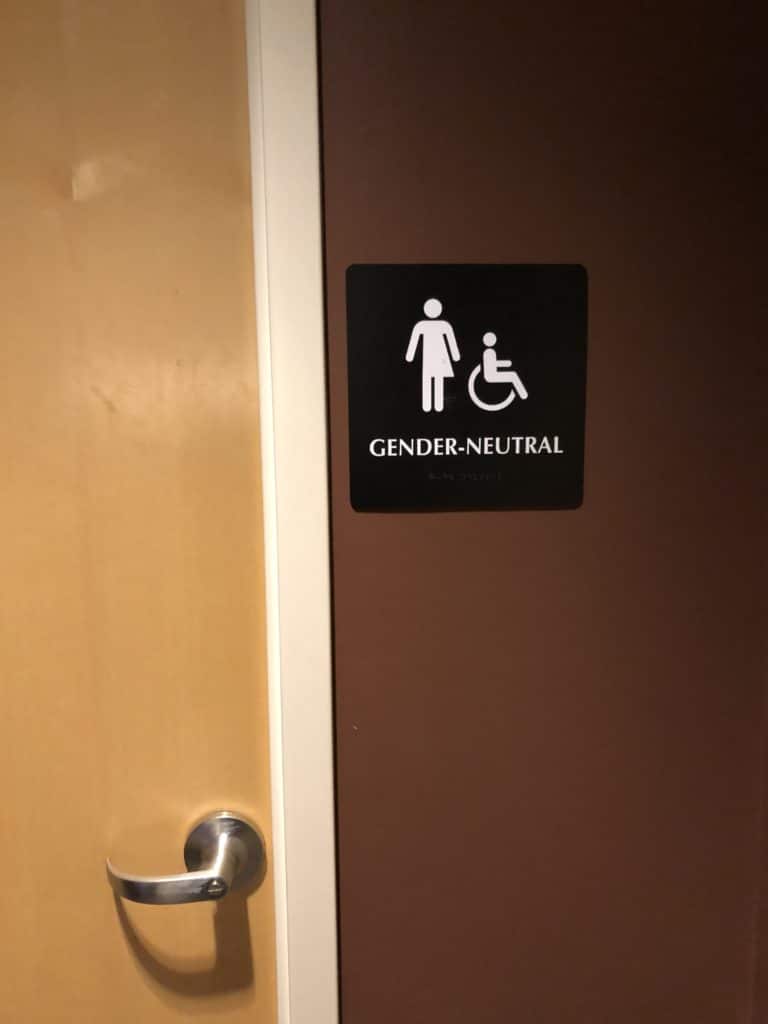
Gender Neutral Restroom at Starbucks
13. Digital Modernization
Starbucks has been focusing on increasing automation and adapting to meet the demands of younger customers. Those demands include more personalization.
In 2022, Starbucks announced a three-year plan to modernize in this area. CEO Laxman Narasimhan says the company is looking ahead to further strengthen its position in digital. This includes innovation to speed up order, payment, and delivery systems and increase personalization.
Starbucks Weaknesses – Internal Strategic Factors
1. High Prices
In order to be profitable while paying its employees above industry averages, maintaining trendy stores, and funding its global expansion, Starbucks needs to charge premium prices for its products. This premium price limits the customer pool as many prospective customers will look to its less pricey competitors to purchase their coffee.
2. Generalized Standards for Most Products
Some of its product offerings are not aligned with the cultural standards of other markets. For example, in some areas, its crafted beverages and food options do not meet consumer preferences for authentic local food and drink options.
3. Worst holiday drink
According to a poll carried out by Mashed, more than 21% of coffee lovers absolutely hate Starbucks’ “Iced Latte.” Starbucks premiered it as a festive Christmas holiday drink. But sadly, the drink turned out to be a downer. A lot of people said the Starbucks’ iced latte leaned too much on the sweet side and was absolutely not worth the steep price.
4. Recall of Products
Over the years, Starbucks has recalled a lot of in-demand products. This can negatively affect the brand image of the company and lead to the loss of its customer base.
The most recent recall involved mugs sold in gift packs, not a food product. The US Consumer Product Safety Commission announced the recall in March 2024. About 440,000 Starbucks-branded mugs made by Nestle were recalled due to burn and laceration hazards. If the mugs are microwaved or filled with too hot liquid, they can break, causing a risk of burns and cuts.
In March 2016, Starbucks recalled two products. One was the sausage, egg, and cheddar breakfast sandwich; the other was a cheese and fruit bistro box. The reason for recalling these products was the threat of contamination and allergens.
During routine testing, it was revealed that the facility that manufactured the breakfast sandwiches had Listeria Monocytogenes on the contact surface.
The 250 stores in Arkansas, Texas, and Oklahoma that showcased these sandwiches had to remove them. The cheese and fruit bistro box was recalled because the box contained traces of undeclared cashew nuts.There was no warning label that highlighted the presence of cashew nuts. This could be potentially life-threatening for people with cashew allergies.
Starbucks Opportunities – External Strategic Factors
1. Coffee Subscriptions
Expanding into coffee subscriptions is a big opportunity for growth. Between 2022 and 2032, coffee subscriptions are forecasted to grow at a CAGR of 10.9% and reach a value of $1.98 billion.
Panera Bread has already started a coffee subscription service. Starbucks can also try a new coffee subscription business model to expand its sales and customer base.
2. Product Diversification
There is an opportunity for Starbucks to develop and market more tea and other non-coffee beverages as consumer preferences change. The global tea market, for example, was valued at $122 billion US in 2022. That’s expected to jump to $160 billion by 2028, for a CAGR of 4.6%.
While it is mostly associated with coffee, a move to diversify its products represents a profit opportunity for Starbucks.
3. More Cold Brew
Demand for cold brew coffee is anticipated to grow at a whopping CAGR of 22.67% between 2024 and 2032, to a total value of $16 billion US.
Starbucks does offer cold brews, but the huge predicted growth in this market highlights an opportunity to expand product offerings.
4. Consumers Demanding Functional Coffee
Between 2023 and 2028, the market size for functional food and beverages is expected to grow at a CAGR of 7.45%. Functional beverages are infused with ingredients or supplements intended to bring health benefits. This growth is part of a wider trend of health consciousness among consumers which is apparent across different age groups.
Starbucks has an opportunity to meet this demand with new and innovative products as consumers look for food and beverages that will support their health and wellness goals.
Starbucks Threats – External Strategic Factors
1. Competition with Low-Cost Coffee Sellers
Many coffee houses offer products at a more affordable price. This could threaten Starbucks’ market share as consumers move to more affordable options.
2. Competition With Big and Small Outlets
Aggressive competition with multinational companies like Dunkin Donuts and McDonald’s can also threaten its market position. But competition in the coffee house market comes from more than the big names. Countless small companies and local coffee shops offer unique experiences, which add up to even more competition in local markets.
3. Third-party Delivery Suppliers (union) Strike
Starbucks’s supply chain consists of many third-party contractors and stakeholders, which makes it difficult to manage the entire chain effectively. A few years ago, Starbucks coffee houses in the Mid-West grappled with shortages after employees of a major supplier went on strike. It’s a scenario that could arise again.
4. Sociocultural Movements
There are many socio-cultural threats to Starbucks. Movements in many places promote ‘buy local’ or encourage consumers to support small businesses. These movements can achieve their aim of discouraging customers from spending their money with large, multinational chains of companies such as Starbucks.
5. Controversy on California Warning Rule
A California judge ruled Starbucks and other companies had to provide warning labels on all their coffee products. This was about preventing a violation of labeling laws related to the use of chemicals that may cause cancer.
6. Philadelphia Arrests
In April 2018, two African-American men were arrested at Starbucks, which caused significant controversy on social media. Starbucks employees refused to let them use the restroom because they didn’t purchase anything. Then-CEO Kevin Johnson eventually issued an apology to both men.
The incident prompted Starbucks and other companies to adopt an open washroom policy, letting anyone, even non-customers, use their facilities. Starbucks has started to shy away from the policy, saying it can’t be America’s public toilet.
7. Change in Customer Behavior
Experts predict the changes in consumer behavior brought on by the pandemic will continue to some extent, such as making more coffee at home or getting take-away rather than consuming beverages within a Starbucks location.
In addition, the decline in the restaurant industry and other macroeconomic factors can adversely affect Starbucks’ development plans and operations.
8. Rising Prices of Raw Coffee Beans
The price of Arabica Beans, the world’s most-produced coffee (representing over 60% of the world’s production), increased drastically during the pandemic due to concerns over its availability, hoarding, and supply chain disruption. Any additional dollar channeled to purchase raw coffee beans at an increased price reduces Starbucks’ profitability.
In addition to the pandemic, ongoing factors like climate change and political instability can cause changes in pricing.
9. Unionization
In December 2021, Starbucks set meetings to negotiate with its Buffalo, New York workers after they voted for unionizing. The company stated that they would talk things out with the workers in good faith. However, Starbucks made its stance clear in a letter sent to its US workers that it would not back the idea of unionizing.
Fast-forward just a couple of years, and more than 8,000 workers at several hundred Starbucks stores in 40 US states have voted to unionize, furthering the effort started by the Buffalo workers.
10. Starbucks Put on the Spot for Dietary Racism
Dietary racism involves compelling BIPOC communities (Black, Indigenous, and People of Color) to eat unhealthy foods, offering limited food options at cheaper costs. According to a publicity stunt by Switch4Good, the prank effectively called out Starbucks on its tactics, which involved charging extra to substitute non-dairy products for milk.
11. Imitability of Products
Starbucks doesn’t own the most unique products in the market. This makes the imitation of its products relatively easy for other companies. Other coffee shops and food chains like McDonald’s McCafe and Dunkin Donuts offer almost identical products.
Starbucks is at risk of copying its products by its competitors, who can offer them at lower prices.
12. European Tax Avoidance
Due to its tax avoidance in the UK, it faced several controversies and criticisms.
The European Commission has been working to stop tax avoidance for some time. Starbucks is one of several corporations the commission is targeting. While the campaign has faced legal setbacks, it has helped raise awareness and applied political pressure. Reuters’ investigation found that Starbucks didn’t pay tax on its £1.3 billion in sales in the three years before 2012.
13. Procurement Practices
Many social and environmental activists criticized the company for its unethical procurement practices. They claimed that it procures coffee beans from impoverished third-world farmers and has also been accused of violating “Fair Coffee Trade” principles.
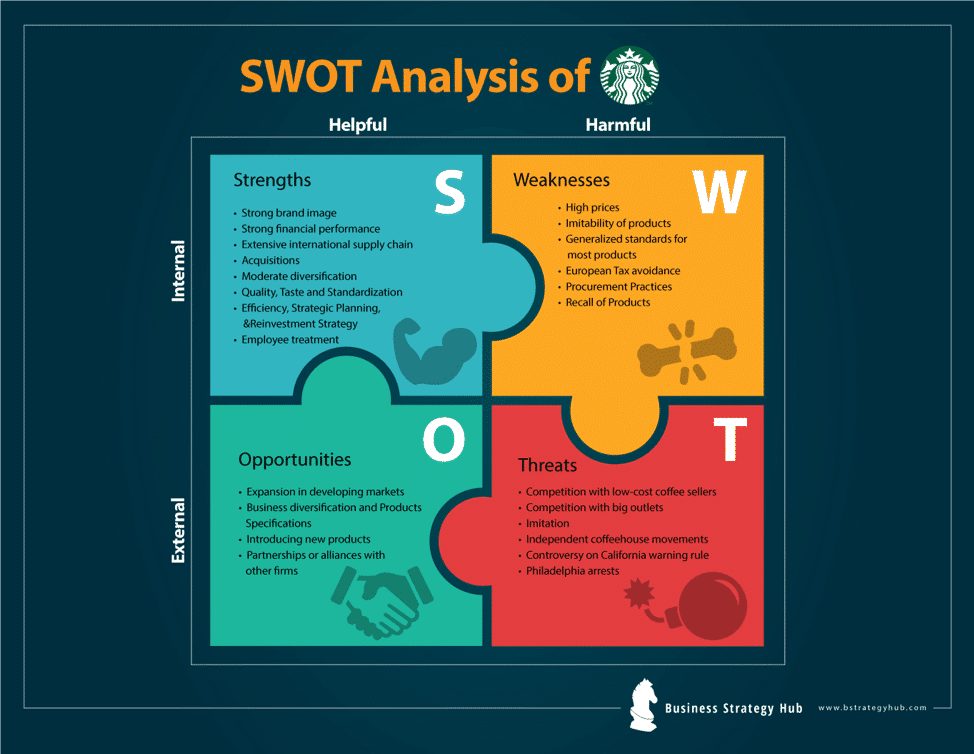
SWOT analysis of Starbucks
Recommendations
Starbucks needs to make some improvements and advancements to keep its market position stable and strong.
A few recommendations for doing this are given below:
- Introduce diversification in products and service offerings. This will help strengthen their position.
- Bring innovation and technological advancements to the company to deal with rising competition and imitation.
- Resolve the issues with social activists who oppose international market players.
- Reduce prices of the products to attract more customers and increase the affordability for all classes of consumers. A two-tiered approach, offering both budget and premium options, would be practical.
- Implement creative marketing campaigns, promotional activities, and branding strategies.
- Contribute to community development and participate in Corporate Social Responsibility (CSR) and sustainability practices.
References & more information
- Euronews Business (Feb 2024). Anti-Tax Avoidance Campaign Update
- Statista (Nov 2023.) Number of Starbucks Stores Worldwide
- Interbrand (2023). Best Global Brands 2023
- Diginomica (Aug 2023). Starbucks Digital Re-invention
- Starbucks (Jan 2019). Starbucks Company Profile
- Green Matters (Dec 2021). What Is Dietary Racism?
- Yahoo Finance. (May 2024) Starbucks Corporation (SBUX) Income Statement – Yahoo Finance
- Fact.MR (2022) Coffee Subscription Market
- Fortune Business Insights (2024, July 1) Cold Brew Coffee Market
Tell us what you think? Did you find this article interesting? Share your thoughts and experiences in the comments section below.


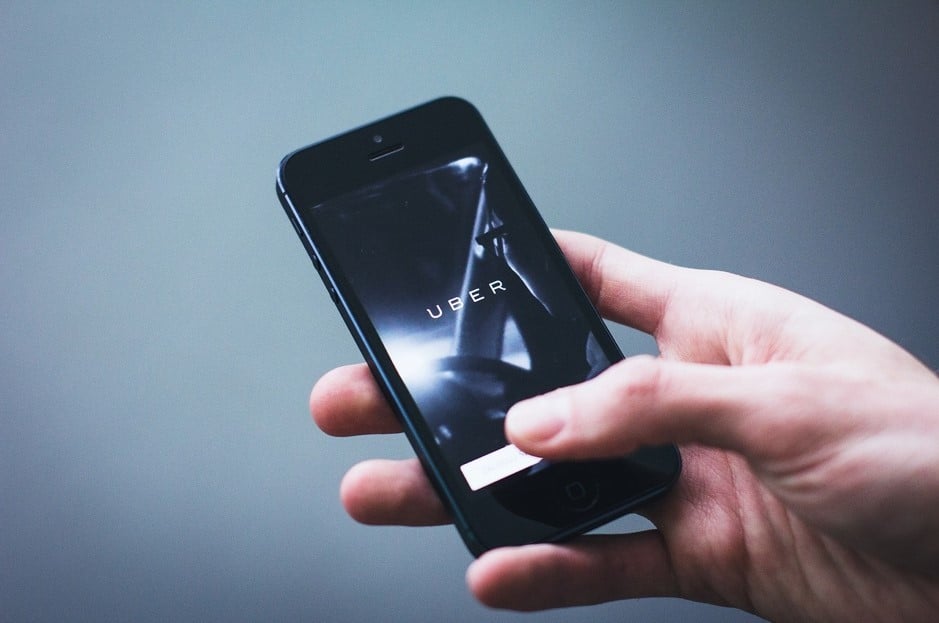




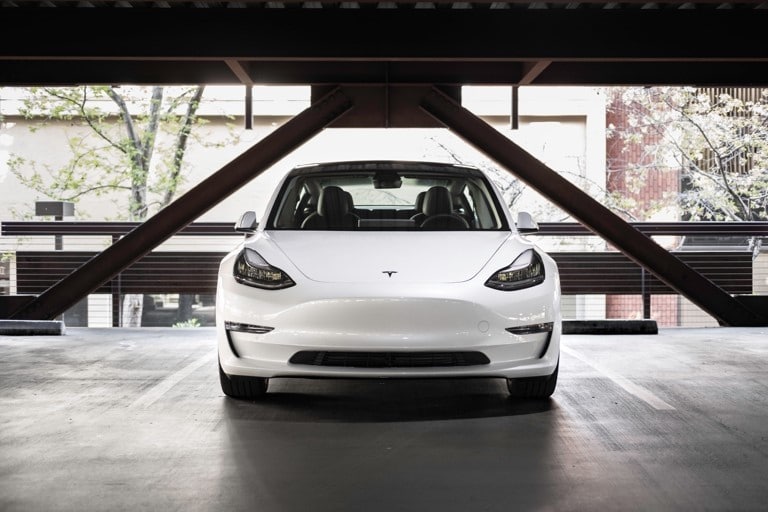

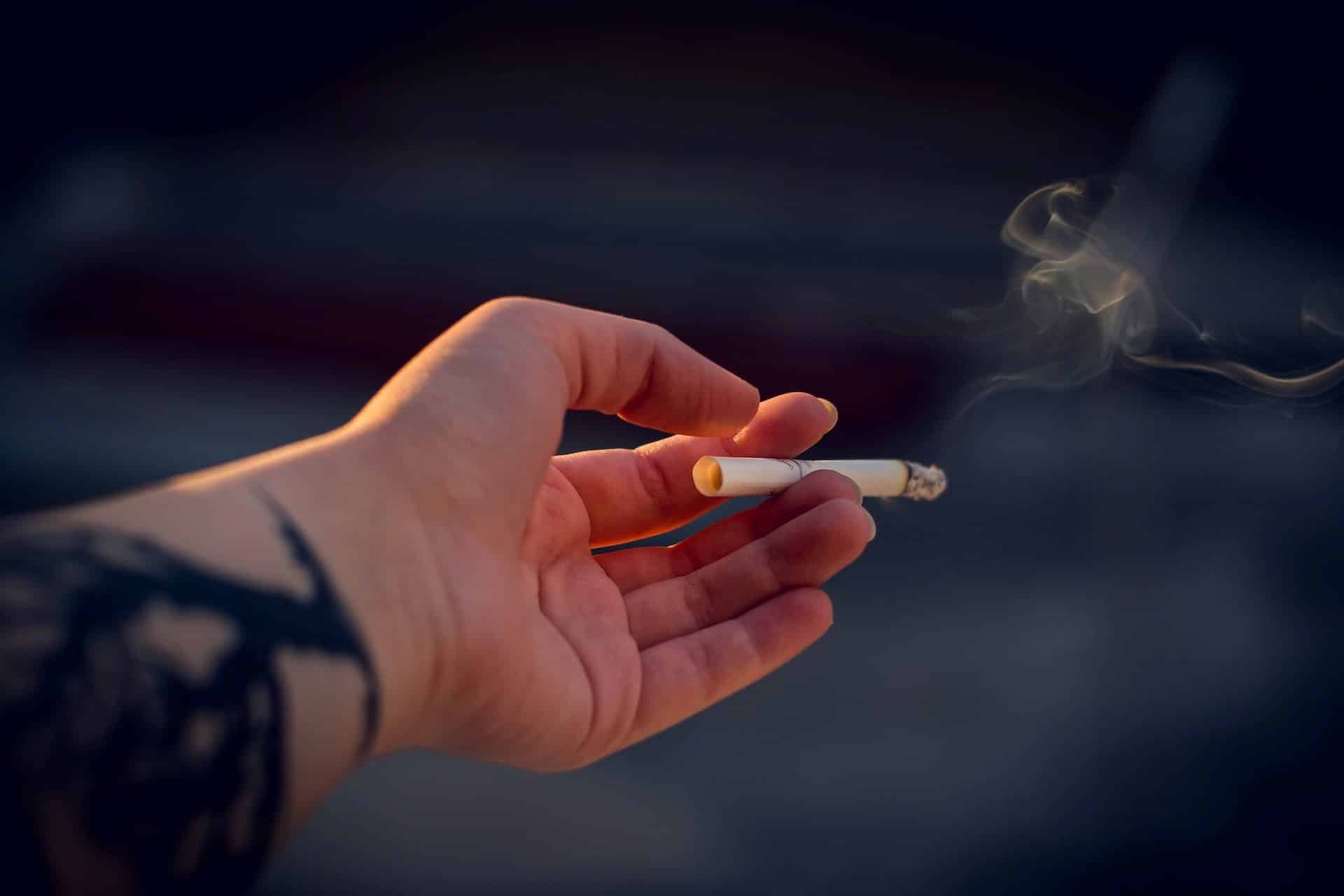
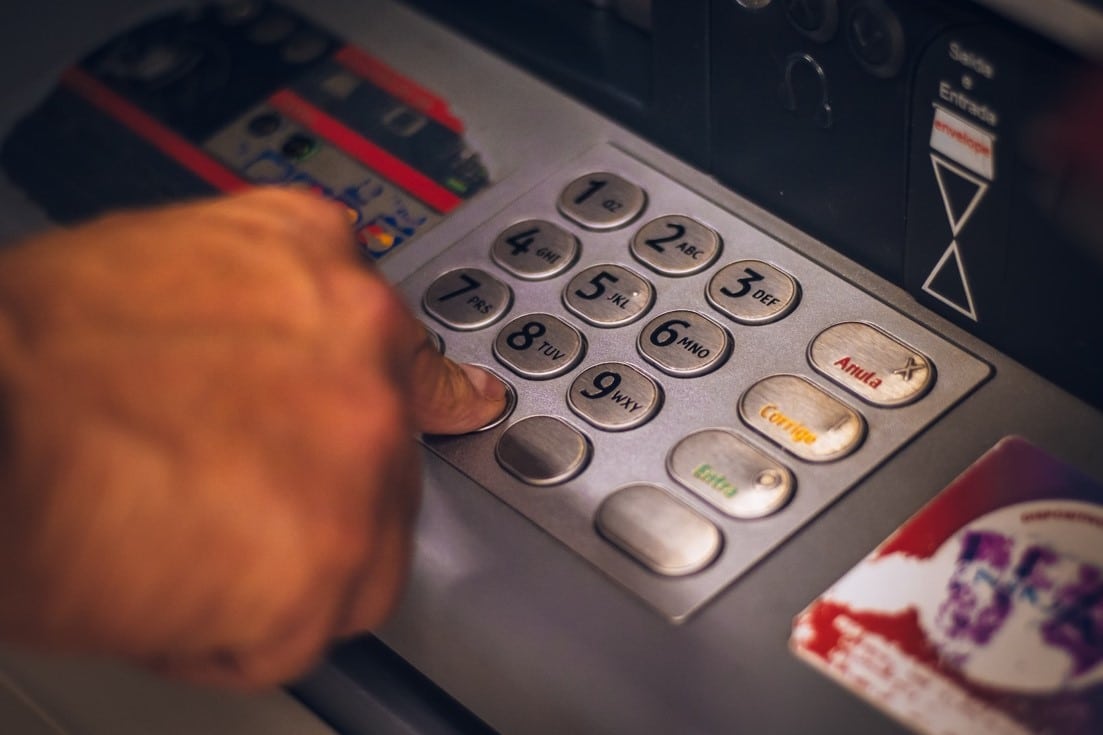

This SWOT analysis is so professional , knowledgeable and helpful for the readers . A worth reading write up .
Respect !
Thank you !!!
Thank you! Very detailed and thorough.
Thank you Shauna for the word of appreciation, glad you liked our analysis.
This is very good
Thank you !
It was quite interesting to read the SWOT analysis of Start Buck
Glad you liked it Shekhar.
Happy Reading 🙂
I think the new labor cuts are going to work the crew more to a breaking point in high sales stores, only having 3 total workers in the afternoon and having high sales, will make lines long, wait times will be long, and customers pulling off an walking out. Also the stress level for workers will make them stressed and customers stressed also. It’s a know fact that increase sales you need more labor, cutting hours will not help you build sales, it only helps your bottom line and at a large cost to crew and customer base.
Awesome SWOT! I love everything about this layout! One question, I cannot verify that they were ever on the Top 100 places to work. Am I missing something? I see tons of different accolades for them, but I couldn’t find this one. Thanks! Again, fantastic job!
Hi JonMcCutcheon,
Glad you liked our SWOT analysis.
Starbucks has been ranked by Fortune (and others) in the “Best Companies to work for” category a few times – Source 1) CNN Money, Source 2) CNN Money
Sources 3) Glassdoor
Hope this helps, Happy Reading!